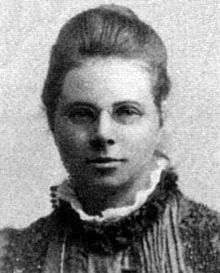Hilda Phoebe Hudson
| Hilda Phoebe Hudson | |
|---|---|
 Hilda Phoebe Hudson | |
| Born |
11 June 1881 Cambridge |
| Died |
26 November 1965 Chiswick |
| Nationality | British |
| Education | Camdridge, Bryn Mawr and Dublin |
| Occupation | mathematician |
| Known for | Cremona transformation |
| Parent(s) | Professor William Henry Hoare Hudson |
Hilda Phoebe Hudson (June 11, 1881 Cambridge – November 26, 1965 London) was an English mathematician who worked on algebraic geometry, in particular on Cremona transformations. Hudson was interested in the link between mathematics and her religious beliefs.
Life and work
Hudson was born in Cambridge where her father, William Henry Hoare Hudson, was a fellow. Her mother was Mary (born Turnball) and she died when Hudson and her three siblings were young. Her father took on the parenting role and she published a simplified Euclidean proof aged ten in the journal Nature.[1]
Hudson gained a scholarship and entered Newnham College at the University of Cambridge, after a year studying at the University of Berlin she returned to Newnham as lecturer in mathematics and later Associate Research Fellow. She was also awarded MA and ScD degrees by Trinity College, Dublin. Most of Hudson's research was in the area of pure mathematics concerned with surfaces and plane curves, her special interest was in cremona transformation. Her monograph Ruler and Compasses[2] was well-received as "a welcome addition to the literature on the boundary between elementary and advanced mathematics".[3] In 1917 she joined an Air Ministry subdivision undertaking aeronautical engineering research, where she applied pioneering work on the application of mathematical modelling to aircraft design for which she was appointed OBE in 1919. As a distinguished mathematician she was one of the few women of her time to serve on the council of the London Mathematical Society.
Notes
- ↑ Mary R. S. Creese, ‘Hudson, Hilda Phoebe (1881–1965)’, Oxford Dictionary of National Biography, Oxford University Press, 2004 accessed 5 Dec 2015
- ↑ Hudson, Hilda P. (1916). Ruler and Compasses. London: Longmans, Green and Company.
- ↑ Review of Ruler and Compasses, 1916, Retrieved 4 December 2015
References
- Hudson, Hilda Phoebe (1927), Cremona transformations in plane and space, Cambridge University Press, ISBN 978-0-521-35882-8, Reprinted 2012
- O'Connor, John J.; Robertson, Edmund F., "Hilda Phoebe Hudson", MacTutor History of Mathematics archive, University of St Andrews.
- Semple, J. G. (1969), "Hilda Phoebe Hudson", The Bulletin of the London Mathematical Society, 1 (3): 357–359, doi:10.1112/blms/1.3.357, ISSN 0024-6093, MR 0246741